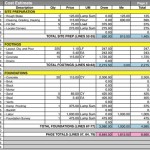Floor Plans For Real Estate Agents
Floor plans are an essential tool for real estate professionals. They serve a variety of purposes including helping potential buyers envision the layout and size of a property, aiding in the marketing of a listing, and assisting with the appraisal process. Understanding how floor plans are measured and created, and how to use them effectively can be a valuable asset for any real estate agent.
Floor plans are typically drawn to scale, using a ratio of 1:100 or 1:50. This means that 1 centimeter on the floor plan represents 100 or 50 centimeters in real life. The scale of the floor plan is usually indicated in the title block or legend. In addition to a scale there are other symbols used on floor plans that real estate professionals should be familiar with. These symbols include:
- Walls: Walls are represented by solid lines. The thickness of the line indicates the thickness of the wall.
- Doors: Doors are represented by small rectangles with a line indicating the direction of the door swing.
- Windows: Windows are represented by small squares or rectangles. The number of lines in the symbol indicates the number of panes in the window.
- Stairs: Stairs are represented by a series of small lines or steps.
- Furniture: Furniture may be included on floor plans to give potential buyers an idea of how the space can be used.
Floor plans can be used for a variety of purposes by real estate agents. Some of these purposes include:
- Marketing: Floor plans can be used in marketing materials to help potential buyers visualize the layout and size of a property. They can be included in brochures, online listings, and other marketing materials.
- Showings: Floor plans can be provided to potential buyers at showings to help them better understand the layout of the property. They can also be used to help potential buyers remember the property after the showing.
- Appraisals: Floor plans are often used by appraisers to help them determine the value of a property. The appraiser will use the floor plan to measure the square footage of the property and to assess the layout and condition of the property.
Floor plans are an essential tool for real estate professionals. By understanding how to read and use floor plans, agents can better serve their clients and close more deals.
Tips For Using Floor Plans
- Look for the scale in the title block or legend. The scale will tell you how to measure the floor plan.
- Use a ruler or measuring tape to measure the dimensions of the rooms.
- Pay attention to the symbols used on the floor plan. The symbols will tell you about the location of walls, doors, windows, stairs, and furniture.
- Use the floor plan to visualize the layout of the property. Consider how the rooms flow together and how the space can be used.
- Make copies of the floor plan to use for marketing, showings, and appraisals.
By following these tips, real estate agents can use floor plans to better market properties, assist potential buyers, and close more deals.

Create Professional Real Estate Floor Plans

Create Professional Real Estate Floor Plans

Why Are Floor Plans Not Used In Real Estate Marketing Mr Williamsburg

Redraw Floor Plan For Real Estate Agents Property Manager Upwork

Real Estate Agency Creates Unique Floor Plans

Real Estate Agents Create 3d Walkthroughs Roomsketcher

Top 10 Best Floor Plan For Real Estate Agents

Real Estate Agents Compare To Floor Plan Smart E Plans

Redraw Floor Plan For Real Estate Agent By Floorplan Vn Fiverr

Redraw Floor Plan For Real Estate Agents Property Manager Upwork








